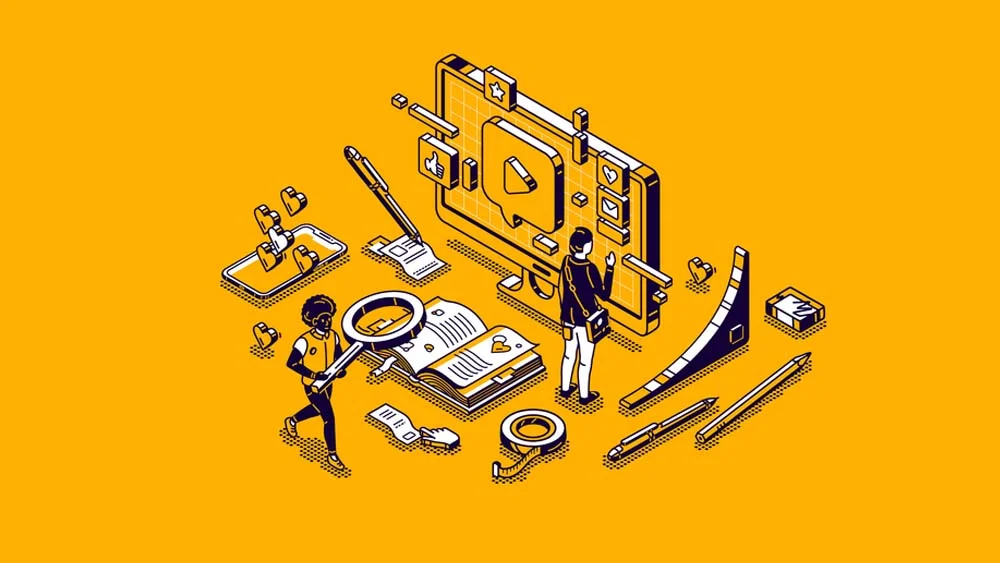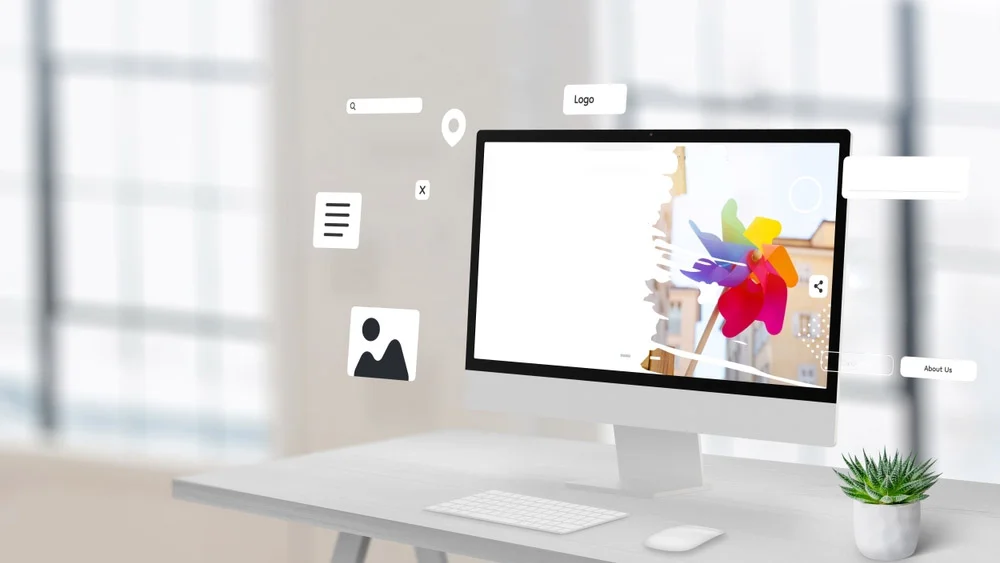In short: graphic design is a profitable field. But getting started on your own as a freelancer can feel intimidating, especially in a digital age where we’re overrun with information and a surplus of “how to” guides.
So I’ve made sure this isn’t your average “how to” guide. In this post, you’ll learn exactly how to get graphic design clients with specific tips that won’t leave you needing to Google something else.
1. Build up your portfolio
Your portfolio is the backbone of your graphic design business, so you need to nail it. The only way to build a portfolio is to start publishing your design work.
But with or without clients, how do you do that?
Many clients make you sign NDAs (Non-Disclosure Agreements), which prevents you from re-publishing the work you’ve done for them on your portfolio. You essentially give up your rights to that project once it’s submitted.
Other clients don’t mind. If that’s the case, perfect. You can show that project to as many new potential clients as you like.
Here are a few other unique ways you can quickly build your portfolio.
-
- Start with personal projects. If you’re new or only have a few clients, create mock projects to showcase your skills. Design app icons, logos, websites, or branding packages for made-up companies—whatever your niche is.
- Work on passion projects. Odds are the reason you’re a graphic designer is that at some point, you loved art—drawing, designing, painting, etc. Look back on your previous passion projects and try to build off them. For example, you can turn an old tattoo you drew into a fictional company’s logo.
- Do a little bit of free work. In my experience, this tip works the best. Offer to do around three graphic design gigs for free, but only in exchange for testimonials. I did this on LinkedIn so that the three free clients I worked with would post their testimonials directly in my LinkedIn recommendations. Which I then reused on my website.
- Post your work to platforms like Dribbble and Behance. These websites let you publish your designs, allowing you to build a portfolio directly on their site. You can also see other designers’ work and get feedback from within the community. Plus, they both have job boards (more on this later).
- Reach out to startups and nonprofits. These organizations often need design work but might have limited budgets. Offering to design for them—whether for free or for a small fee—is the perfect way to get your foot in the door.
2. Create an attractive website that represents your work
A graphic designer with an unattractive website doesn’t get clients. Aside from your portfolio, your website is another way you’ll show clients you have the skills they want on their team.
The main goal of your website should be to provide an excellent user experience (UX). But how do you do that?
Let’s take a look at a few websites created by LawRank, a company that specializes in web design for lawyers.
First, we have Attorney Brian White.
The website has a clear color theme and in one sentence, they explain who they are—Houston Personal Injury Attorneys. In one more sentence, they explain what they do—help Texas accident victims.
And they include a succinct call-to-action (booking a free consultation).
They also included their Google review score as social proof in the corner and the main image is moving, giving it a modern, animated look.
Speaking of CTAs, here’s another excellent example that’s not legal-related.
Jorge Argota includes a compact, visually appealing sidebar with what he does and a CTA on his “About Me” page—so no matter how much of the page someone reads, they’re still reminded of who he is and are prompted to take action.
Next, we have The Law Offices of Jay S. Knispel.
This website uses one main font that identifies the brand—one of LawRank’s web design best practices. In just one glance, you can see who Jay S. Knispel is, what he does, who he works with, and read a short client testimonial that builds social proof.
Next, there’s Kenny Habetz Injury Law.
This isn’t the first thing you see on his website. For this one, I chose to focus a few scrolls down.
The page is very compact with a big font and clear, concise phrases and sentences—such as “over a decade of legal experience” and the CTA (“call [number] for a free consultation”). The font is also creative, giving Kenny Habetz a differentiating style no other lawyer identifies with.
Finally, there’s the live chat—an important element that lets new site visitors know they’re supported.
Last but not least, there’s Attorneys of Chicago, which does an incredible job displaying social proof.
They include the logos of companies that have awarded or listed them as being among the best lawyers, such as Top 100 Lawyers Magazine. Directly underneath they make a case for why potential clients should choose them and then highlight client reviews and testimonials.
3. Pitch gigs on graphic design job boards
Now that you have a portfolio and a website, it’s time to start going after new clients.
This is the most challenging part for many designers, especially when you’re new. But I’m going to provide you with the steps to continue refining your pitching process so that as time goes on, it’s less intimidating and much more effective at getting you clients.
First, choose two or three graphic design job boards and aim to pitch 3-5 gig postings per day. This only takes about an hour a day, and as time goes on, you’ll get faster.
Here are some of the most popular job boards for graphic designers:
- Behance
- Dribble Job Board
- Coroflot
Before making your first pitch, take about half an hour to draft up a pitch template. Here’s a brief overview of the template I use that has won me several clients:
- Briefly greet the client and wish them a happy day/weekend/start of the year/etc.
- Introduce yourself in two lines—say who you are and what you do.
- Name drop (if possible)—mention someone big in the industry you’ve worked with and/or a brief overview of your experience.
- Link to 2-3 examples of your previous work
- Link to your portfolio and/or website
- Tell them something about yourself as a person outside of your graphic design work in about 2 sentences.
Keep a record of all your pitches—I used Google Docs—and put a start emoji next to the one(s) that win clients. Then continue to reuse them for your future pitches.
4. Collect testimonials
Testimonials are strong social proof that can play a huge role in converting leads into clients.
According to Wiser Notify, over 92% of B2B consumers read testimonials before making a purchase. And sales increase by 34% when positive reviews are on sales pages.
But you don’t have to wait until you’ve worked with tons of clients to get testimonials. Here are a few ways you can collect them within your first few projects:
- Request testimonials after every job. After completing a project, ask your client for a short testimonial. Make it easy by offering a few prompts or a template for them to follow.
- Ask for LinkedIn recommendations. This helps build your credibility not just on LinkedIn but also as a general testimonial you can display on your website.
- Follow up with old clients. If you’ve done a graphic design project (or a few) in the past, reach out to old clients you’ve had positive experiences with and ask if they’d write a brief testimonial for you.
- Offer discounts or free work in exchange for testimonials. This goes back to my tip in section #1, but offering free or discounted work for just two or three people builds your portfolio and gives you extremely valuable social proof you can use for the rest of your business’s life.
Once you have a decent number of good testimonials, you can display them prominently in a place where future clients are bound to see them.
For Percy Martinez, he he added a link to his hundreds of five star Google reviews on his homepage:
5. Grow your network
As you become more established in your freelance designer career, you should prioritize making valuable connections. These could lead to referrals, word-of-mouth traffic, valuable collaborations, and much more.
Here are a few ways freelance graphic designers can network:
- Attend networking events and meetups. Attend both in-person and virtual design conferences, such as Adobe MAX or AIGA events. These let you meet other creatives and industry leaders. Also, look into joining local or regional design meetups. This could include creative gatherings, coworking space events, or workshops. Platforms like Meetup.com or Eventbrite are great for finding these.
- Attend online design webinars, workshops, or portfolio reviews. And always aim to interact with attendees through chat and post-event discussions.
- Join online design communities. Engage in forums like Reddit’s r/graphic_design, Slack groups, or Facebook groups dedicated to graphic designers. These communities often share job opportunities and offer critiques or advice.
- Direct message brands you’d like to work with or admire. Don’t hesitate to reach out to businesses or agencies that align with your style. Tailor your message to how you can help them with your design solutions.
- Cold outreach. This one’s become a bit more controversial in recent years, but many freelancers still find outreach methods like cold emailing effective. Research small businesses or startups that could benefit from your skills and offer a tailored solution to them. You can use tools like Hunter to find their email addresses.
- Join and be active in professional associations. Organizations like the American Institute of Graphic Arts (AIGA) let you connect with other designers, attend exclusive events, and provide access to resources for your career development. There’s also Freelancers Union, which hosts networking events, resources, and a community of like-minded professionals.
FAQs on How to Get Graphic Design Clients
How much should a beginner graphic designer charge?
The average graphic designer charges $31.01 an hour according to the U.S. Bureau of Labor Statistics, but can charge as much as $150. Most resources advise beginners to charge between $25 to $50 per hour.
Where are graphic designers needed the most needed?
According to Noble Desktop, the industries offering the most opportunities to graphic designers right now are marketing, publishing, and manufacturing.
Where should a beginner graphic designer start?
If you’re a beginner graphic designer and still wondering where to start, the best place is your education. Learn design principles, take a course, choose and master a design program like (Canva, Venngage, Adobe Illustrator, GIMP, etc. )and practice your skills a lot.
Conclusion
Mastering how to get graphic design clients isn’t complicated—it just requires consistency. With these simple steps, you’ll fill up your clientele faster than you expected.
As your graphic design business grows, you might want to look into creating an app to host all your clients. Think streamlined communication, deadline management, video and voice calls, etc.
That’s what nandbox is for. nandbox lets you create a mobile app in just minutes. You can get started with a 14-day free trial.





